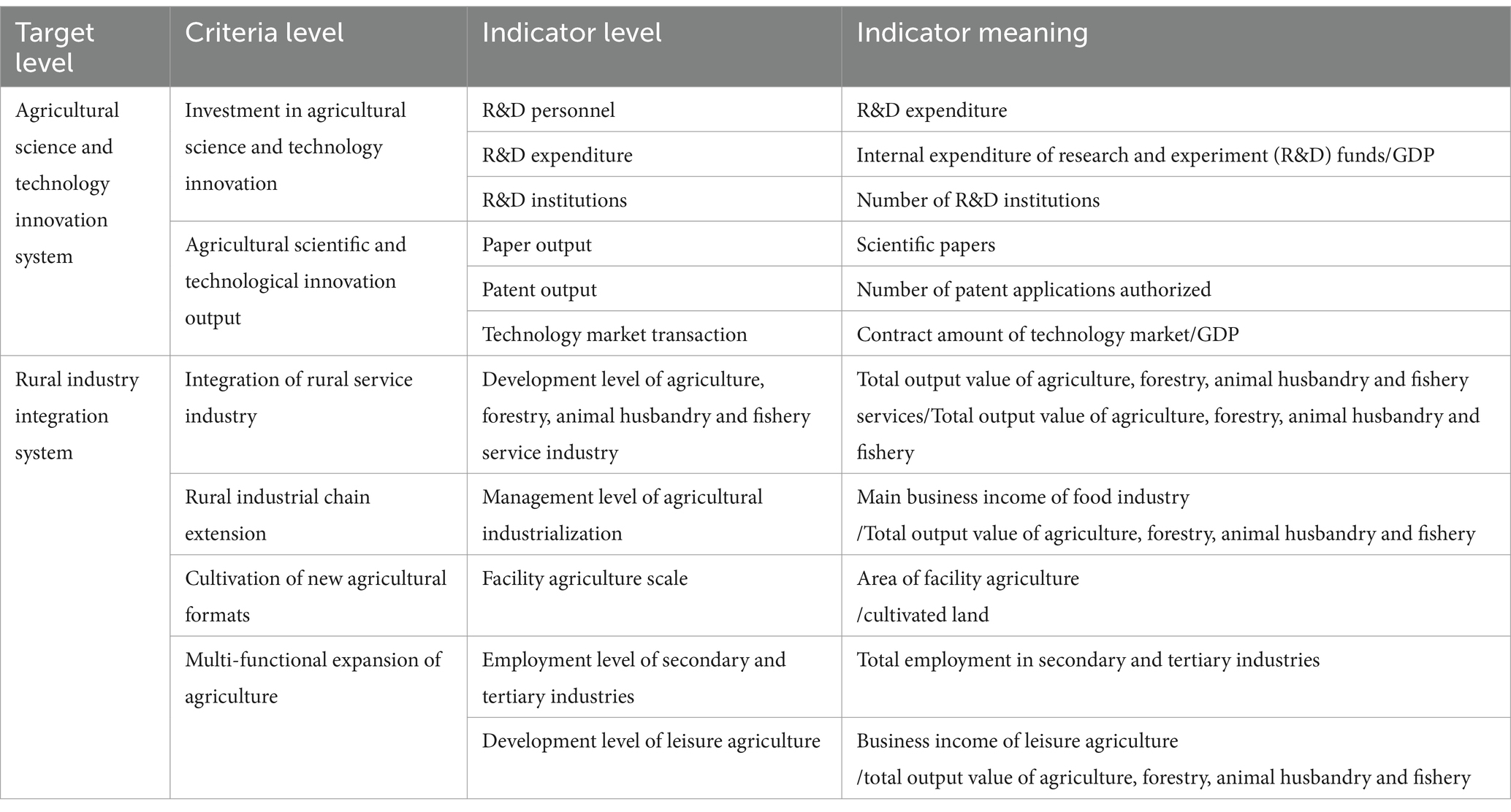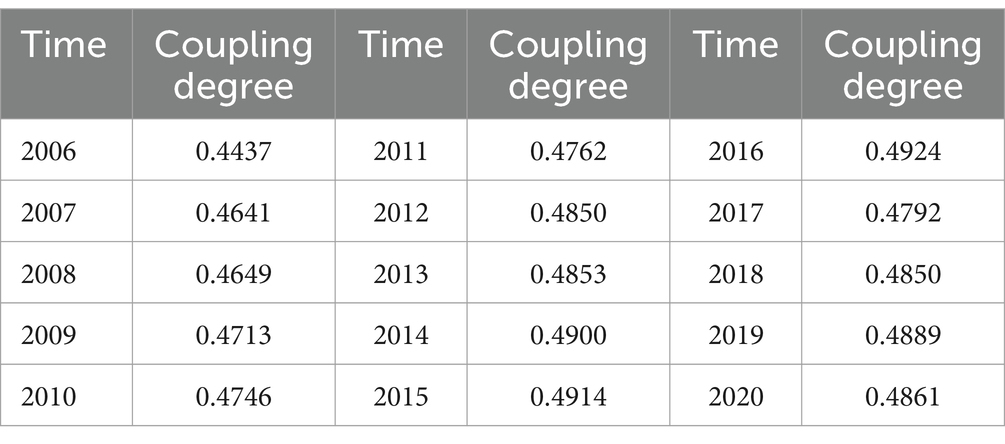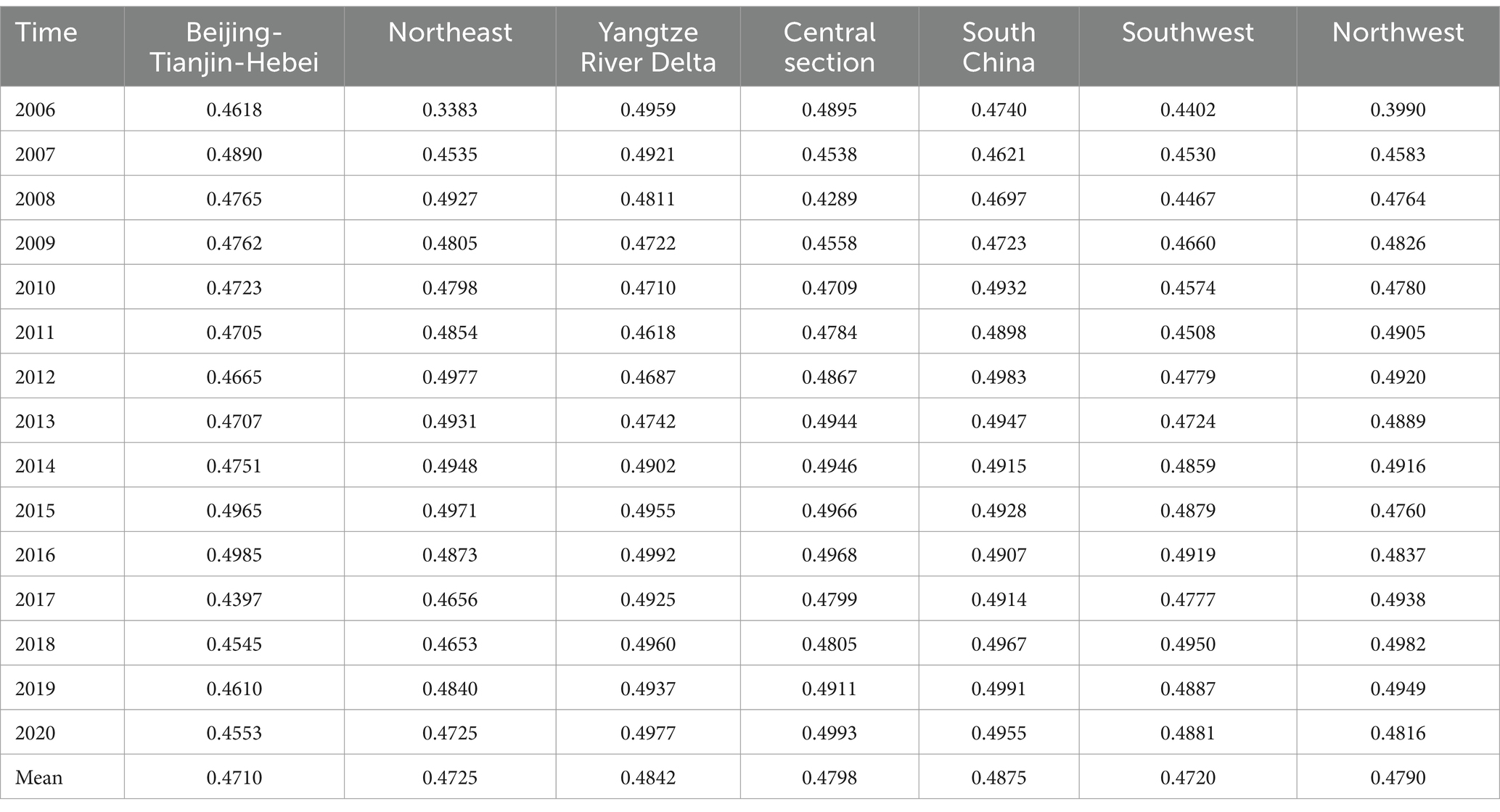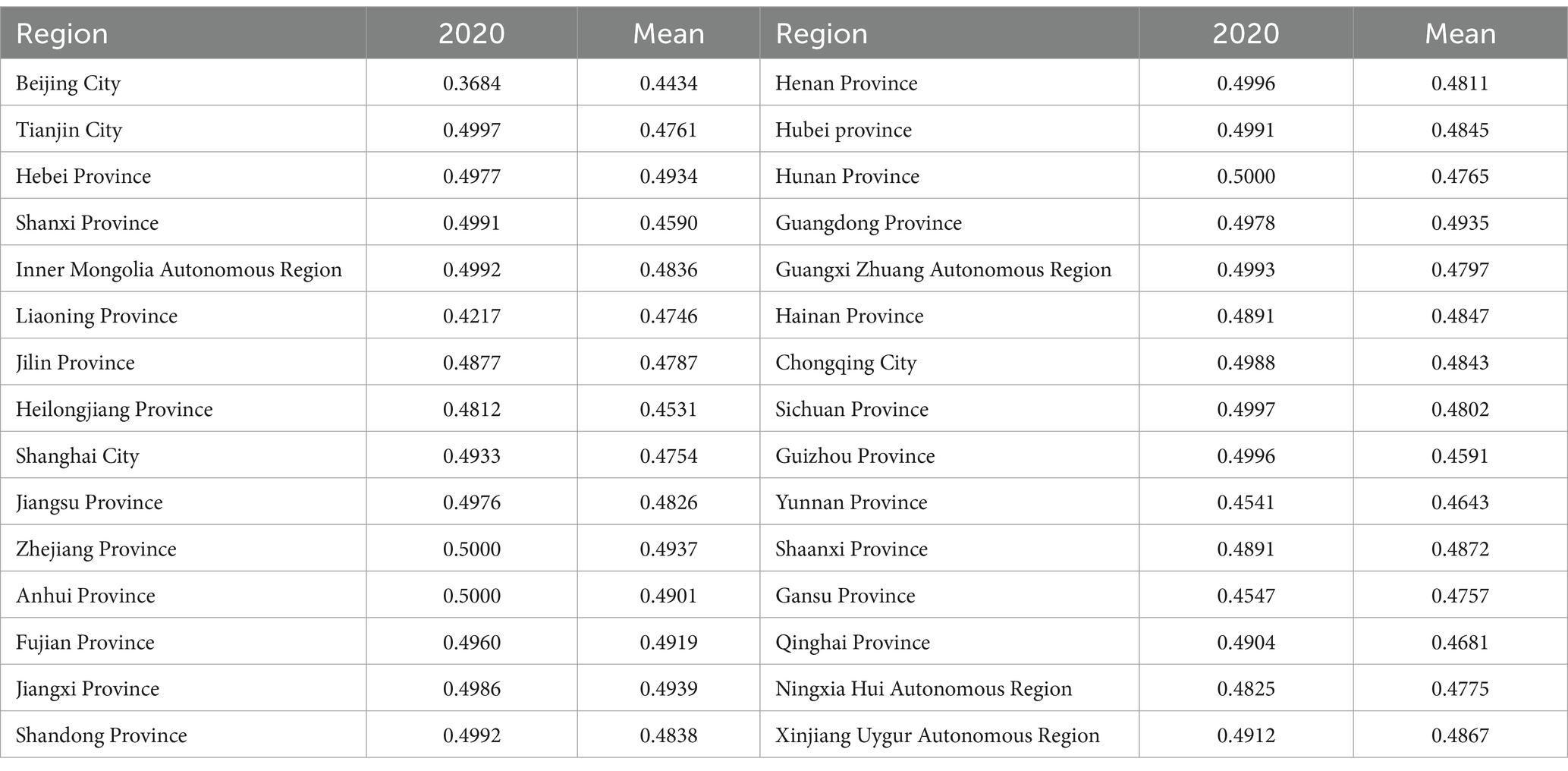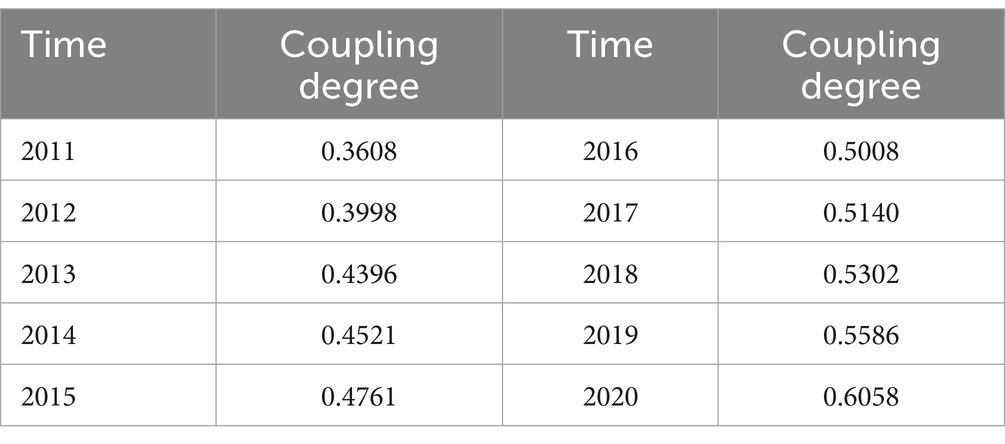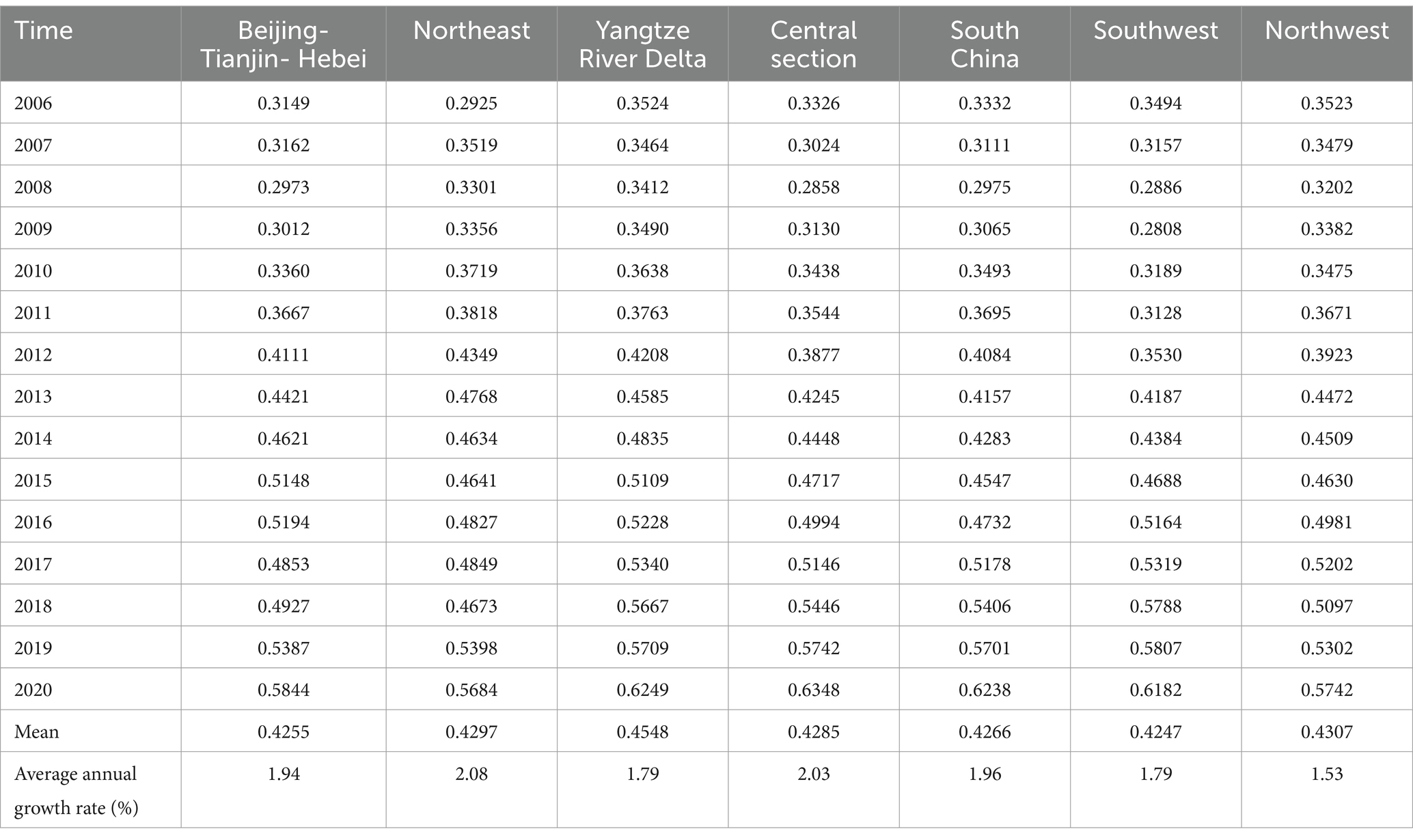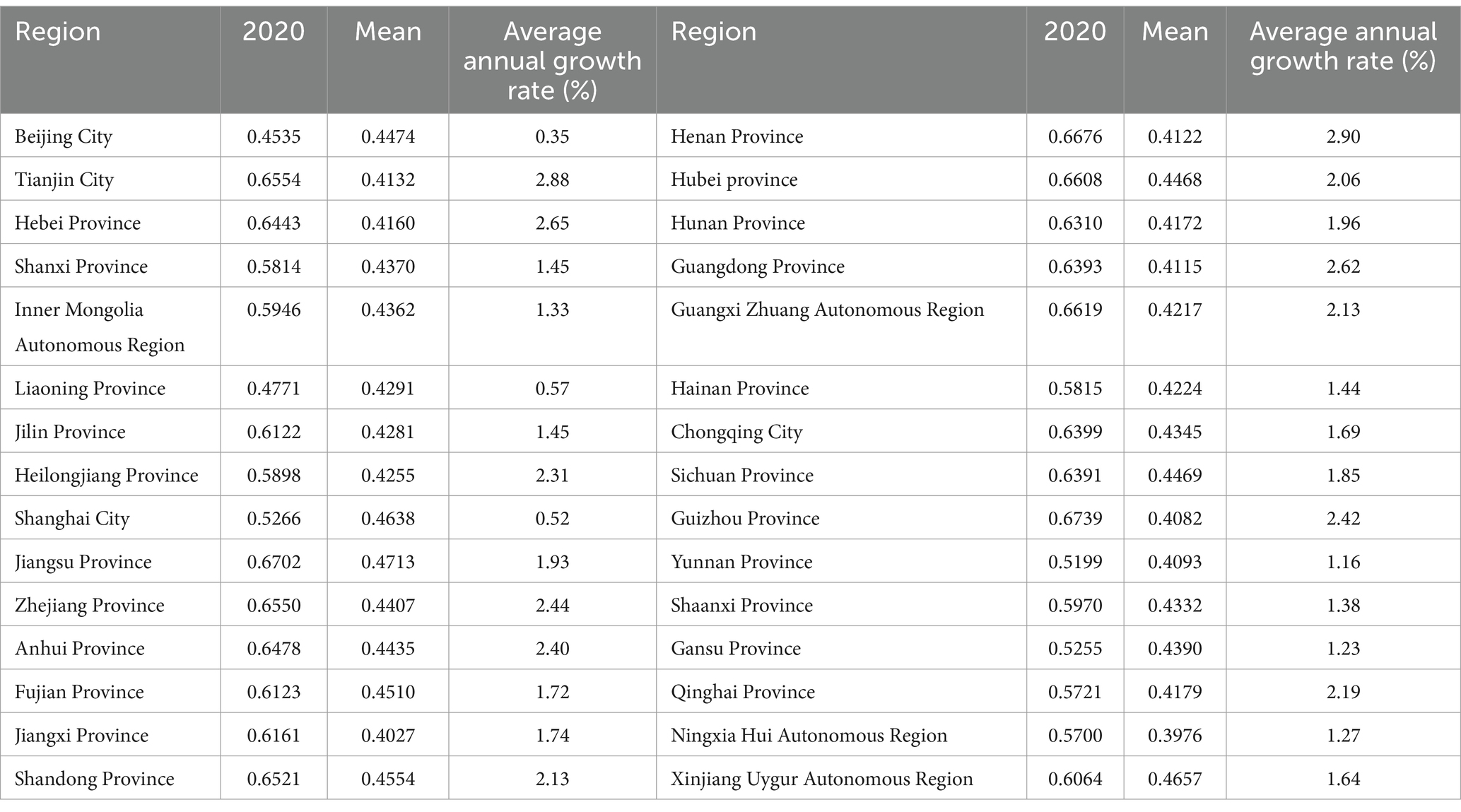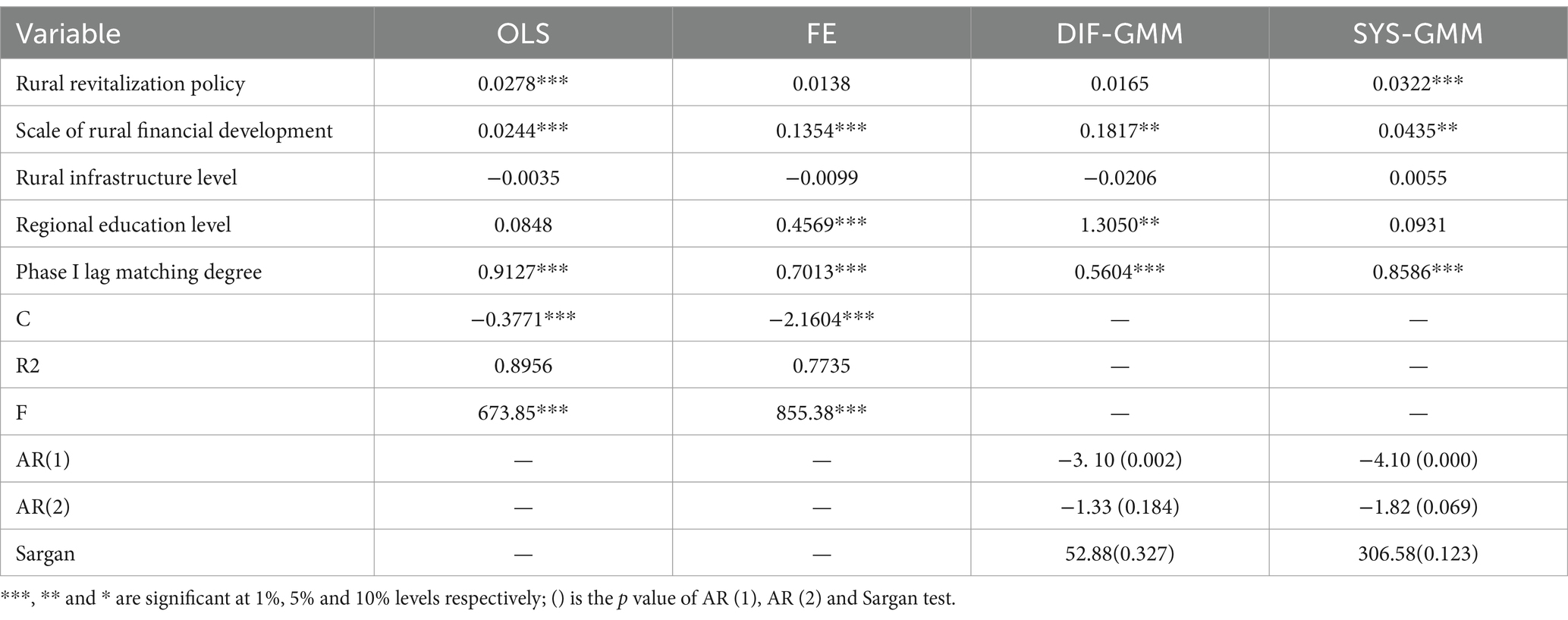- 1Institute of Agricultural Economics and Information, Anhui Academy of Agricultural Sciences, Hefei, Anhui Province, China
- 2School of Economics and Management, Institute of Sustainable Development, Huzhou University, Huzhou, Zhejiang, China
Agricultural scientific and technological innovation and rural industry integration are the key contents of promoting agricultural and rural modernization in China. This study empirically analyzed the matching relationship between the two and its influencing factors, and found that the matching degree between agricultural scientific and technological innovation and rural industry integration in China showed a steady upward trend in the sample period. Both China as a whole and all regions completed the upgrading from moderate to high matching in the sample period, The performance of each region is also excellent. In 2020, the matching degree of 28 regions will enter a high matching range. The implementation of the rural revitalization policy will help to improve the matching degree between China’s agricultural scientific and technological innovation and rural industrial integration. The scale of rural financial development and the matching degree of lagging one period also have a significant positive impact on the improvement of the matching degree. This study further proposes relevant policy recommendations from improving the supply level of agricultural scientific and technology innovation, enhancing the adaptability between supply and demand of agricultural scientific and technology innovation, improving the policy support system, and optimizing the financial security system.
1 Introduction
Sustainable agricultural development is based on protecting the environment and ensuring resources, while meeting the needs of current and future generations. To achieve sustainable agricultural development, China has taken various measures, including promoting ecological agriculture, strengthening scientific and technological support, and protecting biodiversity. By strengthening technological support, China can improve agricultural production efficiency and resource utilization efficiency, and achieve sustainable development of agriculture. Agricultural science and technology innovation and rural industry integration are the key contents of China’s agricultural and rural modernization. In various documents issued by China in the field of “agriculture, rural areas and farmers,” the two usually accompany each other and are important means to achieve rural revitalization.
In China’s rural revitalization strategy, rural industry development is at the core, and industrial integration is the key to rural industry development. The rural industrial integration is a dynamic process to realize the cross integration of primary, secondary and tertiary industries based on agriculture, which is an important link in building a modern agricultural industrial system. While the rural industry is restructured through the two paths of vertical extension of the industrial chain and horizontal expansion of agricultural multi-function, it also drives the rationalization and upgrading of the rural industrial structure and the emergence of new business forms, new models and new attributes, improves the industrial competitiveness and leads the transformation and upgrading of rural industries.
High quality economic growth is driven by the improvement of scientific and technological innovation (Romer, 1990). As long as the latest technology is adopted, any traditional industry can become a modern industry (Hong, 2015). The development of China’s rural industries involves a wide range of areas, with many links, complex technologies and various types, and needs to be interconnected (Li et al., 2016), making support from agricultural science and technology particularly important. Building a good interaction mechanism between agricultural scientific and technological innovation and rural industry can effectively solve the “two skin” problem between scientific and technological innovation and industrial development, and promote the deep integration of the two; Through scientific and technological innovation, solve the scientific and technological difficulties that constrain industrial development, cultivate new growth points in the industry, form new driving forces, improve the level and level of rural industries, and drive rural industries to achieve high-quality development.
Humphrey and Hubert (2002), Kongsamut et al. (2001), Lahorgue and Cunha (2004), Ngai and Pissarides (2007), Acemoglu and Guerrieri (2008) and Russu (2015) and other studies have confirmed that support from scientific and technological innovation or technological innovation can help and improve industrial development, and these results provide a strong reference for this paper in terms of research context. Further, at the level of industrial integration, the research on industrial integration caused by inter industry technology correlation (Sahal, 1985). Kodama (2014) and Kim et al. (2015) also emphasized the importance of technological integration and innovation for industrial integration; The research of Hacklin et al. (2013) not only focuses on technology integration, but also on the role of knowledge integration in industrial integration. Heo and Lee (2019) pointed out that technology convergence will affect industrial convergence through market convergence path.
Among the existing achievements focusing on the integration of rural industries in China, many studies have confirmed the positive role of agricultural scientific and technological innovation in the development of rural industries with theoretical analysis. For example, Liang (2016) believes that scientific and technological innovation is an important foundation and key driving force for the integration of rural industries. Zhao et al. (2017) regarded technological innovation as an indispensable engine to drive the occurrence and development of rural industrial integration. Zhang (2015) believed that the emergence and popularization of a large number of new technologies not only changed the technical route of the original agricultural production, but also enriched the content and form of agricultural industry management, changed the original consumption characteristics of agricultural products, and gave birth to a large number of new formats and business models of multi industry integration. Driven by scientific and technological innovation, new concepts, new technologies, new formats, new models, etc. have infiltrated and integrated into all aspects of agriculture, making the boundaries of various agricultural industries gradually blurred (Shi and Duan, 2019), promoting the upgrading and sustainable development of agricultural industrial clusters, and promoting the innovation of industries, formats and products (Wei and Wei, 2021).
However, a few studies found that the relationship between agricultural scientific and technological innovation and rural industry in China needs to be improved through empirical analysis. For example, Yao and Zhang (2021) pointed out that there are problems on both sides of supply and demand, such as insufficient innovation capacity, disconnection from market demand, and insufficient backward force effect. There is no mutually reinforcing endogenous relationship between agricultural scientific and technological innovation and rural industry. Song (2013) believed that with the continuous improvement of the level of scientific and technological innovation, the deviation between the agricultural industrial structure and scientific and technological innovation has increased due to the weakness of agricultural scientific and technological innovation, the small number of achievements transformation and industrialization, and the weakening of demand.
Although the existing research has provided experience for the development of this paper in the general direction, when it comes to the integration of agricultural scientific and technological innovation and rural industries, the simple theoretical analysis can no longer meet the needs of China’s reality, and there are few studies that judge by quantitative analysis. Therefore, the marginal contribution of this study lies in that: firstly, based on theoretical analysis, an empirical analysis was conducted on the matching degree between China’s agricultural science and technology innovation and rural industry integration, providing a judgment basis for the matching level between the two. Secondly, this article takes the rural revitalization policy as the core independent variable and empirically analyzes the influencing factors of matching degree, providing reference for how to further improve the matching level.
2 Theoretical analysis framework
This study analyzes the logical relationship between agricultural scientific and technological innovation and rural industrial integration in the framework of two dimensions: the scientific and technological supply of agricultural scientific and technological innovation to rural industrial integration and the reverse impact of rural industrial integration on agricultural scientific and technological innovation. In the supply dimension, the rise from technological innovation to scientific and technological innovation reflects the change of innovation sources. Scientific and technological innovation is a generalization of technological innovation with scientific discovery as the source, reflecting the close connection and integration of knowledge innovation (scientific discovery) and technological innovation (Hong, 2015). Therefore, this study further subdivides the supply dimension into two directions: knowledge innovation and technology innovation.
From the dimension of agricultural science and technology innovation to the science and technology supply of rural industry integration. First of all, knowledge innovation is an innovation with universities as the main body and a breakthrough in scientific thinking (Hong, 2013). Agricultural knowledge innovation has paved the way for important basic research on rural industrial integration. Although these basic research has strong principles, rationality and regularity, and cannot directly affect rural industrial integration, knowledge innovation is the source of innovation, which provides necessary knowledge for other innovation activities, and is the basis and source of scientific and technological innovation (Liu, 2016). Therefore, it is still the starting point for agricultural science and technology innovation to drive rural industry integration, and with the spread, diffusion, deformation and upgrading of agricultural knowledge innovation, this impact will gradually deepen. Secondly, agricultural technological innovation has brought a direct effect on the realization of rural industrial integration. Technological innovation has broken the technical barriers between different sub industries within the agricultural industry and between agriculture and the secondary and tertiary industries (Zhao et al., 2017), promoted the cross-border intensive allocation of technology, capital and resource elements, and organically integrated agricultural production, agricultural product processing and sales, catering, leisure and other service industries, Closely connect the primary, secondary and tertiary industries in rural areas, so as to realize the extension of agricultural industrial chain, the expansion of industrial scope and the increase of farmers’ income (Ma, 2015). The impact of agricultural technology innovation on rural industrial integration is distributed in industries, industries, enterprises, elements and other aspects, with the industrial technology structure as the main impact path; The diffusion of technological innovation among different industries brings about technological integration. Technological integration enables different industries to form a common technological foundation, which enables different industries or different industries within the same industry to cross and bond with each other, thus catalyzing the blurring of boundaries between different industries, and further driving them toward integration, forming new industrial attributes or new industrial forms (Chen, 2007).
From the perspective of the reverse impact of rural industrial integration on agricultural science and technology innovation. First of all, the rural industry integration provides a realistic docking platform for the convergence and integration of agricultural knowledge innovation and agricultural technology innovation. On this platform, scientific discovery is transformed into new technologies and adopted, so that scientific discovery results can be timely and effectively transformed into products and technologies, and promote the vigorous development of new technologies, new industries and emerging industries (Hong, 2016). Secondly, with the promotion of the integration of the rural primary, secondary and tertiary industries in the vertical and horizontal paths, the demand for agricultural scientific and technological innovation has become increasingly clear and specific, the standards have been constantly improved, the characteristics of green, intelligent, information-based, digital and human culture have been constantly strengthened, and the demand for agricultural scientific and technological innovation has been continuously enhanced, This change from demand will conduct a reverse transmission along the path of agricultural scientific and technological innovation affecting rural industrial integration, prompting agricultural scientific and technological innovation to optimize, adjust and even subvert innovation according to the guidance of the demand side, changing the direction, speed and scale of agricultural scientific and technological innovation, and adversely affecting the iterative upgrading of agricultural scientific and technological innovation to form a new scientific and technological level and structure.
3 Research methods
3.1 Variable selection
3.1.1 Variable selection for matching degree analysis
Matching degree analysis is carried out for two systems: agricultural science and technology innovation and rural industry integration. The index system of agricultural science and technology innovation system includes two secondary indexes: agricultural science and technology innovation input and agricultural science and technology innovation output, in which the input index consists of three tertiary indexes: R&D personnel, R&D funds and R&D institutions, and the output index consists of three tertiary indexes: paper output, patent output and technology market transaction. Because the above index values of agricultural statistics cannot be obtained directly, this study draws lessons from related studies (Chen et al., 2018; Wang and Liu, 2022), using the gross output value of agriculture, forestry, animal husbandry and fishery/regional gross output value as the weight, converts the above indicators, and separates agricultural science and technology innovation from it.
The index design of rural industrial integration system refers to the related research results of Li and Ran (2019) and Wang et al. (2021). This paper designs an index system composed of four secondary indicators and five tertiary indicators, including rural service industry integration, rural industrial chain extension, new agricultural format cultivation and agricultural multi-functional expansion. The meaning of indicators is shown in Table 1.
3.1.2 Selection of variables for influencing factor analysis
In view of the factors that may affect the matching degree, the core independent variable of this study is the rural revitalization policy. This is because the implementation of the rural revitalization strategy is the general grasp of China’s “three rural” work in the new era. The implementation of the rural revitalization strategy has a huge impact on China’s agricultural and rural areas, which makes this policy variable have a potential exogenous impact on the matching degree of agricultural scientific and technological innovation and rural industrial integration.
At the same time, this study also considers four other control variables. (1) The scale of rural financial development: Rural finance is related to the financial constraints of rural industrial development, and this article measures the balance of agricultural loans. (2) Rural infrastructure level: The level of rural infrastructure not only affects the supply quality of agricultural scientific and technological innovation, but also affects the acceptance level of rural industries toward agricultural scientific and technological innovation. This article uses village road mileage to measure. (3) Regional education level: On the one hand, the education level of a region affects the progress of agricultural technological innovation, and on the other hand, it affects the development of rural industrial integration. This article uses the per capita education years as a measure. (4) Phase I lag matching degree: The matching degree of agricultural technology innovation and rural industry integration may be affected by the previous period. This article measures the matching degree of lagging one period of agricultural technology innovation and rural industry integration. The variables that affect the factor equation are shown in Table 2.
3.2 Model settings
The steps to analyze the matching degree of agricultural scientific and technological innovation and rural industrial integration are: first, calculate the weight of each index in the two systems, then calculate the coupling degree of the two systems, and then calculate the matching degree again; Entropy method, coupling degree model and matching degree model will be used in turn.
3.2.1 Model setting for matching degree analysis
3.2.1.1 Entropy method
Dimensionless treatment of indicators
Where: x represents the original value of each indicator. If the indicator value is larger, the better, then this indicator is defined as a positive effect indicator, otherwise it is defined as a negative effect indicator; Xi represents the standardized value of each indicator, xmax represents the maximum original value of each indicator, and xmin represents the minimum original value of each indicator.
To avoid meaningless when taking logarithm of the standardized value of indicators, the standardized indicator data is translated:
Where: m = 1,2,......, b; n = 1,2,……,aO
Proportion of the m evaluation object in the n index Pmn:
Where: m = 1,2,......, b; n = 1,2,……,aO
Information entropy of the nth indicator:
Where: m = 1,2,......, b; N = 1,2,..., a, k are constants, and the value interval of En is 0, 1.
Difference coefficient of the nth index:
Weight of the nth indicator:
3.2.1.2 Coupling model
In this study, the coupling degree model is used to analyze the strength of the coupling relationship between the two systems of agricultural scientific and technological innovation and rural industrial integration, which indicates the coupling degree between the two systems. In order to evaluate the indicators of agricultural scientific and technological innovation, the evaluation function of agricultural scientific and technological innovation is constructed:
In order to evaluate the indicators of rural industrial integration, the evaluation function of rural industrial integration is constructed:
In the above formula, is the agricultural science and technology innovation index, i is the number of indicators measuring the agricultural science and technology innovation index, is the weight of the m index of the agricultural science and technology innovation index, and is the standardized value of the m index of the agricultural science and technology innovation index; is the rural industry integration index, j is the number of indicators measuring the rural industry integration index, is the weight of the nth indicator of the rural industry integration index, and is the standardized value of the nth indicator of the rural industry integration index.
Further, according to the capacity coupling theory and coefficient model, the coupling degree function of the two subsystems of agricultural scientific and technological innovation and rural industrial integration is constructed as follows:
The value range of coupling degree is 0, 1. When C = 0, it shows that the correlation between agricultural scientific and technological innovation and rural industrial integration is minimal, which means that there is no coupling relationship between the two systems; When 0 < C ≤ 0.3, there is a low-level coupling relationship between agricultural scientific and technological innovation and rural industrial integration; When 0.3 < C ≤ 0.5, there is a middle low level coupling relationship between agricultural scientific and technological innovation and rural industrial integration; When 0.5 < C ≤ 0.8, there is a medium high level coupling relationship between agricultural scientific and technological innovation and rural industrial integration; When 0.8 < C ≤ 1, there is a high-level coupling relationship between agricultural scientific and technological innovation and rural industrial integration; When C = 1, it indicates that the coupling degree between the two systems reaches the maximum, indicating that agricultural scientific and technological innovation and rural industrial integration achieve a benign coupling.
3.2.1.3 Matching degree model
During the multiyear comparative analysis, although the coupling degree of agricultural scientific and technological innovation and rural industry integration may be the same in different periods, the development process of the two cannot be completely consistent, which makes it impossible to fully and effectively reflect the “efficacy” and “synergy” effects of the two subsystems in the overall system by relying solely on the coupling degree model, resulting in some limitations in the analysis results of the coupling degree model. Therefore, based on the coupling degree, this study further uses the coupling coordination degree model to build a matching degree model to reveal the interactive coupling coordination degree between agricultural scientific and technological innovation and rural industrial integration.
In the above formula, M is the matching degree between the two systems of agricultural scientific and technological innovation and rural industry integration, D is the coupling coordination, C is the coupling degree, and T is the comprehensive coordination index of the two systems of agricultural scientific and technological innovation and rural industry integration, reflecting the overall synergy effect between the two systems and reflecting the coordination level of the two systems; α、β represents the undetermined coefficient, which is taken according to their importance in their respective systems. In practice, it is generally taken as α = β = 0.5.The value range of the matching degree is 0, 1. When 0 < M ≤ 0.3, there is a low matching relationship between agricultural scientific and technological innovation and rural industrial integration; when 0.3 < M ≤ 0.5, there is a medium matching relationship between agricultural scientific and technological innovation and rural industrial integration; when 0.5 < M ≤ 0.8, there is a high matching relationship between agricultural scientific and technological innovation and rural industrial integration; when 0.8 < M ≤ 1, there is a extreme matching relationship between agricultural scientific and technological innovation and rural industrial integration.
3.2.2 Model setting for influencing factor analysis
Due to the use of dynamic panels, this study uses generalized moment estimation (GMM) to estimate the influencing factor equation, and the equation constructed is as follows:
In the above equation, i and t, respectively, represent the region and time. y represents the matching degree between agricultural technology innovation and rural industry integration. x represents the core independent variable, and when α1 is significantly positive, it indicates that the implementation of rural revitalization policies has significantly promoted the degree of matching. Controls represents the collection of control variables. represents a random interference term.
3.3 Data source
Limited by the availability of partial variable data, this study selected panel data from 30 provinces, autonomous regions and cities in China, excluding Hong Kong, Macao, Taiwan and Tibet, for analysis from 2006 to 2020. The sample data used are from China Rural Statistical Yearbook, China Science and Technology Statistical Yearbook, China Statistical Yearbook, China Financial Yearbook, China Leisure Agriculture Yearbook, China Tertiary Industry Statistical Yearbook, and the national greenhouse data system. The study used CPI from 2006 as the base period to flatten the relevant variables. For individual missing data, linear interpolation is used to complete.
4 Results
4.1 Coupling analysis
From the national dimension (Table 3), the average coupling degree of China’s agricultural scientific and technological innovation and rural industry integration in the sample period is 0.4785, which is in the range (0.3, 0.5). There is a medium low level coupling relationship between the two systems. On the time axis, although the coupling degree reached its peak in 2016 and decreased slightly, it still showed a relatively stable growth trend in the sample period.
From the regional dimension (Table 4), the sample regions are divided into Beijing Tianjin Hebei region (Beijing, Tianjin, Hebei Province), Northeast region (Liaoning Province, Jilin Province, Heilongjiang Province, Inner Mongolia Autonomous Region), Yangtze River Delta region (Shanghai, Jiangsu Province, Zhejiang Province, Anhui Province), Central region (Shanxi Province, Jiangxi Province, Shandong Province, Henan Province, Hubei Province, Hunan Province) South China (Guangdong Province, Guangxi Zhuang Autonomous Region, Hainan Province, Fujian Province), Southwest (Chongqing, Sichuan, Guizhou, Yunnan) and Northwest (Shaanxi, Gansu, Qinghai, Ningxia Hui Autonomous Region, Xinjiang Uygur Autonomous Region).
The average coupling degree of each region in the sample period is in the range (0.47, 0.49), which does not show very significant heterogeneity, and belongs to the middle low level coupling relationship; The South China region and the Yangtze River Delta region are relatively high, while the other five regions have little difference with each other.
On the time axis, the coupling degree of each region in each year is generally within the range (0.3, 0.5), which is also a low level coupling relationship; In 2020, the coupling degree of the central region, the Yangtze River Delta region and the South China region is ahead of other regions, while the northeast region and the Beijing Tianjin Hebei region are relatively backward.
From the dimensions of provinces, municipalities and autonomous regions (Table 5), the average coupling degree in the sample period of Hebei, Zhejiang, Anhui, Fujian, Jiangxi and Guangdong provinces exceeded 0.49, while the average coupling degree in the sample period of Beijing, Shanxi, Heilongjiang and Guizhou did not exceed 0.46.
In 2020, the coupling degree of Zhejiang Province, Anhui Province and Hunan Province is 0.5, reaching the critical value of medium to high level coupling relationship, and taking the lead in all 30 sample regions; In addition, the coupling degree of 18 regions exceeds 0.49, and that of 5 regions exceeds 0.48. The coupling degree of these regions is close to the critical value of medium high level coupling relationship; Relatively backward regions mainly include Beijing, Liaoning, Yunnan and Gansu.
4.2 Match analysis
As mentioned above, simply relying on the coupling degree model cannot fully and effectively reflect the “efficacy” and “synergy” effects of the two subsystems in the overall system. Therefore, further analysis of the matching degree of agricultural scientific and technological innovation and rural industrial integration has become the focus of this study.
From the national perspective (Table 6), the average matching degree of China’s agricultural scientific and technological innovation and rural industrial integration in the sample period is 0.4315, which is between 0.3–0.5. There is a moderate matching relationship between the two systems. On the time axis, the matching degree shows an overall growth trend, with an average annual growth rate of 1.87%, especially after 2010, showing a very steady upward trend, with the growth rate reaching 2.44% during 2010–2020.The main reason for the changes is that China has been building new rural areas since 2005, which has greatly promoted the development of rural industries. At the same time, in 2007, China’s agricultural science and technology innovation system was established, increasing its support effect on the development of rural industries. The growth trend of the matching degree in the sample period shows an obvious two-stage feature, which is in a moderate matching during 2006–2015, and after breaking through the critical value of 0.5.in 2016–2020, the matching degree between the two systems will enter a high matching range (0.5, 0.8).
From the regional dimension (Table 7), in the sample period, the Yangtze River Delta region has the largest mean value of matching degree of each region, while the southwest region has the smallest, but the difference between them is only 0.0301; In terms of average annual growth rate, all seven regions have reached a growth rate of at least 1.5%, among which the northeast region is outstanding, followed by the central region, while the growth rate of the northwest region is relatively low.
On the timeline, all regions have completed the upgrading from medium to high matching. The Beijing Tianjin Hebei region and the Yangtze River Delta region entered the high matching region in 2015, the southwest region in 2016, the central region, South China and Northwest region in 2017, and the northeast region in 2019. In 2020, the matching degree of the central region, the Yangtze River Delta region, the South China region and the Southwest region is more than 0.6, while the matching degree of the Beijing Tianjin Hebei region, the Northeast region and the Northwest region is in the range (0.56–0.59).
From the dimensions of provinces, municipalities and autonomous regions (Table 8), The average matching degree of each region in the sample period is within the range (0.3, 0.5) moderate matching level, but the matching degree of all regions has improved to a certain extent in the sample period. In terms of the average annual growth rate, there are 12 regions whose growth rate exceeds 2%, 15 regions whose growth rate is between 1 and 2%, and only 3 regions whose growth rate is between 0 and 1%. Under the background of this growth trend, the matching degree of 28 regions will enter a high matching range in 2020, with a value between 0.5–0.8.
4.3 Analysis of influencing factors
This study also provides the estimation results of OLS, Individual Fixed Effects Model (FE), differential GMM (DIF-GMM) and system GMM (SYS-GMM; Table 9). The differential GMM and system GMM models do not have second-order autocorrelation problems, nor do they have excessive identification problems. This study is based on the estimation results of the system GMM (SYS-GMM). This is because, on the one hand, GMM solves the endogenous problem of the equation, making its estimation results superior to OLS and fixed panel estimation; On the other hand, compared with differential GME, GME has smaller bias and higher efficiency.
The estimated coefficient of the core independent variable rural revitalization policy in SYS-GMM is positive, and has passed the 1% significance test, which shows that after removing the endogenous, the rural revitalization policy has a positive effect on the matching degree. The implementation of the rural revitalization policy helps to improve the matching degree between agricultural scientific and technological innovation and rural industrial integration, which means that China should focus on promoting the rural revitalization policy toward deeper implementation in the future.
In terms of control variables, the estimated coefficients of the matching degree between the scale of rural financial development and the first phase lag are positive, and they pass the significance tests of 5 and 1%, respectively. The improvement of rural financial development scale brings more abundant financial supply, which can effectively improve the matching degree; However, the lag phase I matching degree is obviously regular, which indicates that the matching degree itself has a lag, leading to an inertial trend in its development path. Therefore, it is of great importance to keep the matching degree in a stable development state. The estimation coefficient of the regional education level is positive, but it has not passed the significance test. It may be that China has attached great importance to education for a long time, and the regional education level has been significantly improved in the past period, so that the impact of this variable on the matching degree has not reached a significant level. The estimation coefficient of the regional infrastructure level is also positive, and has not passed the significance test. It may be that the new rural construction since 2005 has effectively improved the construction of rural roads in China, which makes this variable have a positive impact on the matching degree in the sample period of this study, but it has not reached a significant level.
5 Discussion
The positive interaction between agricultural technological innovation and the integration of rural industries contributes to addressing the issue of the “dual identity” problem between agricultural technological innovation and industrial development in rural areas, achieving their coordinated development. Quantitative analysis is needed to determine the level of matching between agricultural technological innovation and the integration of rural industries in China. Additionally, the implementation of the rural revitalization strategy has brought about new changes to China’s agricultural and rural development. The impact of this policy variable on the matching between agricultural technological innovation and the integration of rural industries also requires empirical examination.
Addressing the aforementioned two issues, this study, based on the matching model and Generalized Method of Moments (GMM), examines the matching degree of agricultural technological innovation and the integration of rural industries in China and its influencing factors. Our research finds that the matching degree between agricultural technological innovation and the integration of rural industries in China during 2006–2015 was within the moderate matching range (0.3, 0.5). The main reasons for the failure to achieve a higher level of matching between the two during this period are attributed to issues such as the significant segmentation of agricultural research institutions, insufficient innovation capabilities, low rate of technology transfer, lagging construction of agricultural technology promotion systems, weakening demand for agricultural technological innovation due to imbalanced rural industrial structure development, and the inability of rural industries to generate pressure on agricultural technological innovation (Yao and Zhang, 2021). Although the matching degree between agricultural technological innovation and the integration of rural industries in China was not high during 2006–2015, there was a robust upward trend overall, indicating that the constraints on the matching degree are gradually being addressed (Guo, 2019; Mao et al., 2019; Xiao and Feng, 2020; Qian et al., 2023), and the matching degree between the two ultimately entered a high-level matching phase in 2016, indicating that the interaction between agricultural technological innovation and the integration of rural industries in China has entered a new stage (Wang et al., 2024). The improvement in overall matching degree relies on the improvement of regional levels. The changes in the matching degree between agricultural technological innovation and the integration of rural industries in various regions, provinces, municipalities, and autonomous regions of China during the sample period show a trend similar to the overall trend, and except for individual areas, most have upgraded from moderate matching to high matching.
The implementation of the rural revitalization policy has a significantly positive impact on the matching degree between agricultural technological innovation and the integration of rural industries, indicating that the favorable policy environment brought about by China’s rural revitalization strategy has to some extent eliminated obstacles to raising the matching level between agricultural technological innovation and the integration of rural industries. This finding is consistent with the conclusions of studies by Wang et al. (2022), Yang and Zhu (2024), Zhang (2024), and others. Additionally, rural financial development and lagged matching degree also have a significantly positive impact on the matching degree between rural industries, which is consistent with the conclusions of related studies by Li and Ran (2020), Zhang and He (2023), and others.
Finally, it should be noted that although this study calculates the matching degree between agricultural technological innovation and the integration of rural industries in China and analyzes its influencing factors, there are still limitations. Firstly, the availability of data limits the construction of indicators for agricultural technological innovation and the integration of rural industries, resulting in an incomplete indicator system. Secondly, due to data availability limitations, the number of control variables in the influencing factor model is relatively small.
6 Conclusion and policy implications
Focusing on the integration of agricultural science and technology innovation and rural industry in China, this study first calculated the coupling level between the two by using the coupling degree model, and then further analyzed the matching relationship between the two by using the matching degree model; Then, taking the matching degree as the dependent variable, we used the generalized moment estimation (GMM) to investigate the relevant influencing factors. The research found that: (1) In terms of the coupling degree, whether it is China as a whole, each region or 30 sample regions, There is no breakthrough (0.3, 0.5). There is a medium low level coupling relationship between agricultural scientific and technological innovation and rural industrial integration. However, from the perspective of 2020, there are 3 regions that reach the critical value of medium high level coupling relationship, and 23 regions are close to the critical value of medium high level coupling relationship. These regions are hopeful to achieve breakthroughs in the future. (2) In terms of matching degree, The matching level between China’s agricultural scientific and technological innovation and rural industrial integration showed a steady upward trend in the sample period. Both China as a whole and all regions completed the upgrading from medium matching to high matching in the sample period. The performance of all regions was also excellent. In 2020, the matching degree of 28 regions entered the high matching range (0.5, 0.8). (3) In terms of influencing factors, The implementation of the rural revitalization policy will help to improve the matching degree between China’s agricultural scientific and technological innovation and rural industrial integration; The scale of rural financial development and the matching degree of lagging one period also have a significant positive impact on the improvement of the matching degree. This study can be further studied in at least three areas in the future: firstly, further optimization of indicators for agricultural technology innovation and rural industry integration to improve the accuracy of matching; The second is to explore the intermediary mechanism of agricultural technological innovation on the integration of rural industries; The third is to compare and analyze the relationship between linear and nonlinear perspectives.
The government should improve the supply level of agricultural scientific and technological innovation. First, improve the level of agricultural knowledge innovation, strengthen the construction of agricultural science specialty, create a good innovation environment for knowledge innovation subjects, and steadily increase the investment in knowledge innovation subjects. The second is to improve the level of agricultural technology innovation, establish a positive innovative corporate culture, and let the value of innovation for development become the spiritual power source of enterprise technology innovation; Focus on expanding government investment in innovative activities of agricultural science and technology enterprises; We will strengthen and improve the construction of the innovation market system from the aspects of finance, information, property rights and other elements. The third is to improve the level of coordination and integration between the knowledge innovation system and the technology innovation system. The key is to enhance the interaction between the knowledge innovation subject and the technology innovation subject, so that the double innovation achievements can have an effective interactive transformation, stimulate the potential value of knowledge innovation, and give play to the driving force of technology innovation to real production.
The government should enhance the adaptability of agricultural scientific and technological innovation supply and demand. First, accurately grasp the characteristics of scientific and technological demand of different types of rural industries, and timely carry out more targeted scientific and technological innovation based on demand. The second is to accurately grasp the characteristics of resource endowments in different regions, adjust technological innovation achievements according to regional characteristics, and conduct scientific and technological innovation based on the heterogeneity of resource endowments. The third is to cultivate diversified rural industrial integration subjects and strengthen the connection with universities and scientific research institutions.
The government should improve the policy support system. Give play to the leading role of the government and create a good policy environment. While adhering to the general direction of the rural revitalization policy, we should focus on improving the sub policies included in it, and through the optimization of the sub policies, the corresponding “three rural” areas will be changed accordingly; In the framework of top-level design, regions should formulate more specific policies based on local factor endowment characteristics, enhance the pertinence, diversity, effectiveness, complementarity and flexibility of policy tools, and ensure that all policies can be truly implemented.
The government should optimize the financial security system. First, we will provide more abundant credit support for agricultural scientific and technological innovation and rural industrial integration, unblock financial supply channels, and improve the universality and availability of financial products. The second is to improve the risk prevention mechanism and effectively resolve various risks by building a risk identification and measurement system and an early warning and control system. Third, financial service innovation is carried out according to the characteristics of agricultural science and technology innovation activities and rural industry integration, and targeted development of new models.
Data availability statement
The original contributions presented in the study are included in the article/supplementary material, further inquiries can be directed to the corresponding author.
Author contributions
SY: Writing – review & editing, Writing – original draft, Visualization, Validation, Supervision, Software, Resources, Project administration, Methodology, Investigation, Funding acquisition, Formal analysis, Data curation, Conceptualization. YW: Writing – review & editing, Writing – original draft. GW: Visualization, Validation, Supervision, Software, Resources, Project administration, Methodology, Investigation, Funding acquisition, Formal analysis, Data curation, Conceptualization, Writing – review & editing, Writing – original draft.
Funding
The author(s) declare that financial support was received for the research, authorship, and/or publication of this article. This work was supported by the Philosophy and Social Sciences Planning Project of Anhui Province (No. AHSKY2021D139).
Conflict of interest
The authors declare that the research was conducted in the absence of any commercial or financial relationships that could be construed as a potential conflict of interest.
Publisher’s note
All claims expressed in this article are solely those of the authors and do not necessarily represent those of their affiliated organizations, or those of the publisher, the editors and the reviewers. Any product that may be evaluated in this article, or claim that may be made by its manufacturer, is not guaranteed or endorsed by the publisher.
References
Acemoglu, D., and Guerrieri, V. (2008). Capital deepening and nonbalanced economic growth. J. Polit. Econ. 116, 467–498. doi: 10.1086/589523
Chen, L. Q. (2007). Technological innovation, technological merging and Industru merging. Sci. Technol. Economy 3, 19–22.
Chen, Z., Zheng, R., Li, P. H., and Huang, S. (2018). Evaluation and analysis of agricultural science and technology innovation efficiency in Henan Province. J. Henan Agricultural University 52, 468–469. doi: 10.16445/j.cnki.1000-2340.2018.03.025
Guo, H. H. (2019). The significance and the next step of the reform of agricultural science and technology system during forty years of reform and opening up. Issues in Agricul. Econ. 1, 86–98. doi: 10.13246/j.cnki.iae.2019.01.007
Hacklin, F., Battistini, B., and Von Krogh, G. (2013). Strategic choices in converging industries. MIT Sloan Manag. Rev. 55, 65–73.
Heo, P. S., and Lee, D. H. (2019). Evolution patterns and network structural characteristics of industry convergence. Struct. Chang. Econ. Dyn. 51, 405–426. doi: 10.1016/j.strueco.2019.02.004
Hong, Y. X. (2013). On the innovation–driven economic development. Ecomomist 1, 5–11. doi: 10.16158/j.cnki.51-1312/f.2013.01.008
Hong, Y. X. (2015). Mechanism of industrial innovation and transformation of industrial structure. Econ. Theory and Business Manag. 11, 5–14.
Hong, Y. X. (2016). The discussion on perfection of scientific and technological innovation system and coordinated development. Econ. Perspect. 2, 4–9.
Humphrey, J., and Hubert, S. (2002). How does insertion in global value chain affect upgrading in industrial clusters. Reg. Stud. 36, 1017–1027. doi: 10.1080/0034340022000022198
Kim, N., Lee, H., and Kim, W. (2015). Dynamic patterns of industry convergence: evidence from a large amount of unstructured data. Res. Policy 44, 1734–1748. doi: 10.1016/j.respol.2015.02.001
Kodama, F. (2014). MOT in transition: from technology fusion to technology-service convergence. Technovation 34, 505–512. doi: 10.1016/j.technovation.2013.04.001
Kongsamut, P., Rebelo, S., and Xie, D. (2001). Beyond balanced growth. Rev. Ecomomic Stud. 68, 869–882. doi: 10.1111/1467-937X.00193
Lahorgue, M. A., and Cunha, N. (2004). Introduction of innovations in the industrial structure of a developing region: the case of the Porto Alegre Technopole home brokers project. Int. J. Technol. Manag. Sustain. Dev. 2, 191–204. doi: 10.1386/ijis.2.3.191/1
Li, Y. L., Li, H., and Xiao, H. B. (2016). Research on convergence among primary, secondary and tertiary Industries in Foreign Countries. Word Agricul 6, 20–24. doi: 10.13856/j.cn11-1097/s.2016.06.004
Li, X. L., and Ran, G. H. (2019). How does the rural industrial convergence development affect the urban-rual income gap?- based on the dual perspective of rural economic growth the urbanization. J. Agrotechnical Econ. 8, 17–28. doi: 10.13246/j.cnki.jae.2019.08.002
Li, X. L., and Ran, G. H. (2020). Have enhanced rural financial services promoted the integrated development of agricultural industry? An empirical analysis based on the perspective of regional differences. Res. Agricultural Modernization 41, 453–463. doi: 10.13872/j.1000-0275.2020.0029
Liang, L. H. (2016). Dynamic mechanism, development model and implementation strategy of the three industries convergence in rural areas. Reformation and Strategy 32, 74–77. doi: 10.16331/j.cnki.issn1002-736x.2016.08.016
Liu, X. Z. (2016). Mechanism of the changing of economic development mode based on knowledge innovation. J. Technical Econ. Manag. 3, 104–108.
Ma, X. H. (2015). Promote the integrated development of primary, secondary and tertiary Industries in Ruarl Areas. China Co-operation Economy 2, 43–44.
Mao, S. P., Yang, Y. L., and Lin, Q. N. (2019). The evolution and effect of Chinese Agriculutral science and technology innovation policies since reform and opening up: empirical data analysis from Chinese agricultural research Institiutions. Issues in Agricul. Econ. 1, 73–85. doi: 10.13246/j.cnki.iae.2019.01.006
Ngai, L. R., and Pissarides, C. A. (2007). Structural change in a multi-sector model of growth. Am. Econ. Rev. 97, 429–443. doi: 10.1257/aer.97.1.429
Qian, M. H., Li, H. R., Guo, J. L., and Cui, Y. (2023). Analysis of Chian’s rural industrial integration model and measurement of integration degree: from the perspective of text data mining. Issues in Agricul. Econ. 6, 58–77. doi: 10.13246/j.cnki.iae.2023.06.009
Romer, P. M. (1990). Endogenous technological change. J. Polit. Econ. 98, S71–S102. doi: 10.1086/261725
Russu, C. (2015). Structural changes produced in the Romanian manufacturing industry in the last two decades. Procedia Econ. Finance 22, 323–332. doi: 10.1016/S2212-5671(15)00296-8
Sahal, D. (1985). Technological Guideposrs and innovation avenues. Res. Policy 14, 61–82. doi: 10.1016/0048-7333(85)90015-0
Shi, D. Y., and Duan, L. L. (2019). Comparative study of the rural industrial convergence pattern under the Prespective of supply-side reform: a case study of Sichuan. Agric. Econ. 1, 40–42.
Song, D. J. (2013). The coupled evaluation on Chinese agricultural industry structure optimization and technology innovation. Stud. Sci. Sci. 31, 191–200. doi: 10.16192/j.cnki.1003-2053.2013.02.005
Wang, J. H., Chen, Q. Q., and Gu, J. K. (2022). Research hot spots and evolution trend of agricultural science and technology innovation in China: a visual analysis based on cite space. Sci. Technol. Manag. Res. 22, 8–16. doi: 10.3969/j.issn.1000-7695.2022.22.002
Wang, L. Y., Ding, S. Y., and Liu, H. P. (2021). Impact of rural industrial convergence on farmers’ income growth: an empirical study based on spatial effect and threshold effect. Acta Agriculturae Zhejiangensis 33, 761–776. doi: 10.3969/j.issn.1004-1524.2021.04.21
Wang, O., Kang, Y. X., Zhu, L. L., and Liu, F. J. (2024). Construciton of agricultural powerhouse: historical orientation, connotation characteristics, and key supporting systems. J. Shanxi Agric. Univ. Soc. Sci. Ed. 23, 54–60. doi: 10.13842/j.cnki.issn1671-816X.2024.02.007
Wang, F., and Liu, Y. F. (2022). Agricultural science and technology innovation efficiency and regional difference comparison in China: based on the perspective of grain functional areas. Sci. Technol. Industry 22, 153–161.
Wei, J. F., and Wei, H. (2021). Research on high-quality development of agricultural industry cluster based on technological Progress. J. Yangtze Normal University 37, 21–29. doi: 10.19933/j.cnki.ISSN1674-3652.2021.01.003
Xiao, J. W., and Feng, M. L. (2020). The evolution of the Intergraiton of rural industry in China: the interaction and co-development of benefit connection and production factors. Financ. Econ. 9, 64–78.
Yang, Q., and Zhu, C. H. (2024). The characteristics, process and prospects of China’s road to rural revitalization [J]. Issues in Agricul. Econ. 2, 4–17.
Yao, S., and Zhang, Y. L. (2021). The matching analysis of agricultural science and technology and rural industry development. J. Changzhou University (Social Science Edition) 22, 58–67. doi: 10.3969/j.issn.2095-042X.2021.01.007
Zhang, Y. B. (2015). Industrial Covergence and interaction in the vision of agricultural modernization and its path. Reformation 2, 98–107.
Zhang, H. Y. (2024). The theoretical logic of agricultural powerhouse: investigation and research based on agricultural industry property. Reformation 2, 121–130.
Zhang, L., and He, B. L. (2023). Rural Financial Services for Building an agricultural powerhouse: realistic dilemmas and breakthrough paths. J. Agro-Forestry Econ. Manag. 22, 692–699. doi: 10.16195/j.cnki.cn36-1328/f.2023.06.72
Keywords: agricultural scientific and technology innovation, rural industry integration, influencing factors, match, China
Citation: Yao S, Wang Y and Wu G (2024) Measurement and influencing factor analysis of the matching degree between agricultural scientific and technology innovation and rural industry integration under the sustainable background. Front. Sustain. Food Syst. 8:1362877. doi: 10.3389/fsufs.2024.1362877
Edited by:
Noshaba Aziz, Shandong University of Technology, ChinaReviewed by:
Zhiyuan Xu, Zhejiang Sci-Tech University, ChinaHui Mao, Shaanxi Normal University, China
Kong Fanzhu, Huaiyin Institute of Technology, China
Copyright © 2024 Yao, Wang and Wu. This is an open-access article distributed under the terms of the Creative Commons Attribution License (CC BY). The use, distribution or reproduction in other forums is permitted, provided the original author(s) and the copyright owner(s) are credited and that the original publication in this journal is cited, in accordance with accepted academic practice. No use, distribution or reproduction is permitted which does not comply with these terms.
*Correspondence: Guosong Wu, cGxveWJveTQzOUAxMjYuY29t
 Sheng Yao1
Sheng Yao1 Guosong Wu
Guosong Wu